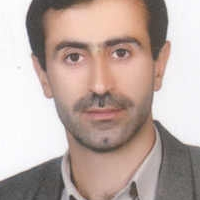Mathematical Modeling and Comparison of the Substrate Induced on Forest and Agricultural Soils
Author(s):
Article Type:
Research/Original Article (دارای رتبه معتبر)
Abstract:
Introduction
Soil is a complex and dynamic biological system, and it still is difficult to determine the composition of microbial communities in soil. Most soil microorganisms are dormant, so their rate of respiration is low. However, their respiration can be stimulated by adding an easily decomposable substrate. Also, by adding a simple organic matter, respiration may rapidly increase to a maximum and remains at a constant rate for more than 4 h. Glucose is commonly used as a substrate because most soil microorganisms can readily utilize it as a carbon source. The substrate-induced respiration (SIR) method was modified and adapted to measure fungal, bacterial and total microbial contributions to glucose-induced respiration and the potentially active microbial biomass on decaying plant residues of different composition. Decomposing residues from natural and agricultural ecosystems were chopped and sieved to include the >1 mm fraction for routine SIR analyses on a continuous flow-through respiration system. Substrate induced respiration is a main factor for the assessment of the soil microbial activity. This technique is already used widely in soil microbial studies. Different factors such as the source of carbon, temperature and incubation may play a significant role in the amount of SIR. Therefore, optimizing the test conditions is one of the important criteria for SIR determination. For this purpose, statistical methods such as central composite design (CCD) and response surface method can be used as a useful tool for determining optimal conditions. This study was carried out to model and compare the effect of carbon source (glucose), temperature and incubation time on the SIR of forest and agricultural soils.
Materials and Methods
In this research, 40 experiments were conducted for two soil types including agricultural soil (with relatively low organic matter content) and forest soil (with relatively high organic matter content). Soil samples were collected from the topsoil (0-20 cm) layer. In the laboratory, all visible roots were removed and the soil samples were divided into two parts. One part was kept in plastic bottles at 4°C for SIR analysis. And the rest was air dried in the shade at laboratory temperature for chemical and physical analysis. Electrical conductivity (EC) and pH were determined in saturated soil extract and organic carbon persent (%OC) was determined by di-chromate oxidation. Soil texture was determined using a Bouyoucos hydrometer in a soil suspension. Response surface methodology based on the central composite design was applied in modeling procedure. Different ranges of the independent variables including glucose (0.5-10 mg g-1), incubation time (1-10 hr), and temperature (15-30˚C) were used in central composite design experiments. Totally, 40 experiments based on the coded values of the independent variables were conducted for two soils.
Results and Discussion
Experimental results indicated that the SIR in forest soil is two times greater than the agricultural soil, which may be related to the higher organic matter content and more microbial activity in this soil. Results also revealed the efficiency of the central composite design in predicting the SIR of forest (R2= 0.823) and agricultural (R2=0.919) soils. Among the three independent variables, the linear effect of temperature on the SIR were significant for both soils. However, the substrate (glucose) content has more significant effect in forest soil in comparison with agricultural soil which may be associated with the higher decomposable organic matter content of the forest soil. Glucose enhancement didn’t have significant effect on SIR alteration rate which can be attributed to low organic matter content in agricultural soil. Totally, with increasing time and temperature, the amount of SIR was significantly increased, however with increasing glucose, SIR amount was not significantly increased especially in the agricultural soil. In the forest soil, the process of SIR changes is clearly distinct in response to independent variables compared to agricultural soil. Maximum levels of the SIR in forest soil is clearly associated to the highest time and glucose levels. This indicates that increasing glucose and sufficient time in the forest soil, which contains high amounts of digestible organic matter, can stimulate microorganisms to decompose more organic matter and it outcome is increasing SIR.
Conclusion
This study indicated the high efficiency of response surface methodology in SIR modeling for both forest and agricultural soils. However, the quantitative amounts of SIR were very different in two soils. The amounts of SIR in the forest soil were almost twice relative to agricultural soil. In the forest soil, the amounts of glucose and temperature were as the main variables in increasing SIR, while the temperature and time variables were more determinant in agricultural soil on it.Keywords:
Language:
Persian
Published:
Journal of water and soil, Volume:32 Issue: 5, 2019
Pages:
919 to 930
magiran.com/p1923908
دانلود و مطالعه متن این مقاله با یکی از روشهای زیر امکان پذیر است:
اشتراک شخصی
با عضویت و پرداخت آنلاین حق اشتراک یکساله به مبلغ 1,390,000ريال میتوانید 70 عنوان مطلب دانلود کنید!
اشتراک سازمانی
به کتابخانه دانشگاه یا محل کار خود پیشنهاد کنید تا اشتراک سازمانی این پایگاه را برای دسترسی نامحدود همه کاربران به متن مطالب تهیه نمایند!
توجه!
- حق عضویت دریافتی صرف حمایت از نشریات عضو و نگهداری، تکمیل و توسعه مگیران میشود.
- پرداخت حق اشتراک و دانلود مقالات اجازه بازنشر آن در سایر رسانههای چاپی و دیجیتال را به کاربر نمیدهد.
In order to view content subscription is required
Personal subscription
Subscribe magiran.com for 70 € euros via PayPal and download 70 articles during a year.
Organization subscription
Please contact us to subscribe your university or library for unlimited access!



